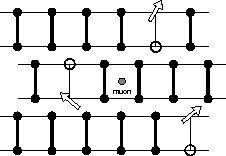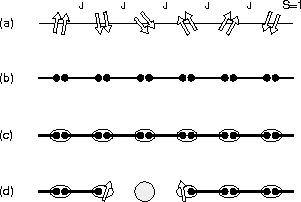



Next: Discussions
Up: 4.3 SR measurements
Previous: 4.3.2 The 2-leg ladder
The magnetic behavior of the 2-leg ladder system differs markedly
from that of the 3-leg system. In Fig.32a, we
show typical  SR spectra in the 2-leg ladder system. Note that
Fig.32 has a horizontal scale about 10 times
larger than that for Fig.29a and
Fig.30. In the 2-leg system, weak
relaxation below
SR spectra in the 2-leg ladder system. Note that
Fig.32 has a horizontal scale about 10 times
larger than that for Fig.29a and
Fig.30. In the 2-leg system, weak
relaxation below  50 K was observed. However, from the
longitudinal field (LF) measurements (Fig.32b),
the source of this relaxation was found to be fluctuating rather than
static internal fields. If the slow relaxation in the zero-field
measurement were due to a static field distribution, the
characteristic field distribution width would be
50 K was observed. However, from the
longitudinal field (LF) measurements (Fig.32b),
the source of this relaxation was found to be fluctuating rather than
static internal fields. If the slow relaxation in the zero-field
measurement were due to a static field distribution, the
characteristic field distribution width would be  G,
as the relaxation rate suggests. In this case, the
G,
as the relaxation rate suggests. In this case, the  SR spectrum
would be flattened in a LF
SR spectrum
would be flattened in a LF 100 G. As shown in
Fig.32b, the relaxation persists up to
LF
100 G. As shown in
Fig.32b, the relaxation persists up to
LF 2 kG, proving that this slow relaxation is a T1-like
dynamical one (see section 3.4).
2 kG, proving that this slow relaxation is a T1-like
dynamical one (see section 3.4).
Figure 32:
a: LF=100 G  SR spectra in the 2-leg ladder system. b:
Longitudinal field decoupling measurements at 20 mK. For both panels
the solid lines are fits with a square-root exponential function.
Note that the horizontal scale is
SR spectra in the 2-leg ladder system. b:
Longitudinal field decoupling measurements at 20 mK. For both panels
the solid lines are fits with a square-root exponential function.
Note that the horizontal scale is  10 times larger than that in
Fig.29a and
Fig.30.
10 times larger than that in
Fig.29a and
Fig.30.
 |
We analyzed the muon spin relaxation in the 2-leg ladder system using
a square-root exponential function ( =
= ), which is appropriate for dilute fluctuating moments (see
section 3.2). The temperature dependence of the
relaxation rate (
), which is appropriate for dilute fluctuating moments (see
section 3.2). The temperature dependence of the
relaxation rate ( ) is shown in
Fig.33. The increase of
) is shown in
Fig.33. The increase of  down to
down to
 40 K indicates a slowing down of field fluctuations. Still the
field fluctuations persists down to the milli-Kelvin regime, as shown
by the saturation of
40 K indicates a slowing down of field fluctuations. Still the
field fluctuations persists down to the milli-Kelvin regime, as shown
by the saturation of  . This result indicates that there is no
static order in the 2-leg ladder material, supporting the theoretical
expectations for the non-magnetic ground state of this system.
. This result indicates that there is no
static order in the 2-leg ladder material, supporting the theoretical
expectations for the non-magnetic ground state of this system.
Figure 33:
Temperature dependence of muon spin relaxation rate ( ) in the
2-leg ladder system. The solid lines are guide to the eye. The inset is
the longitudinal field dependence of the relaxation rate at 20 mK, with
the fit to the T1 relaxation theory (eq.33).
) in the
2-leg ladder system. The solid lines are guide to the eye. The inset is
the longitudinal field dependence of the relaxation rate at 20 mK, with
the fit to the T1 relaxation theory (eq.33).
 |




Next: Discussions
Up: 4.3 SR measurements
Previous: 4.3.2 The 2-leg ladder


![]() =
=![]() ), which is appropriate for dilute fluctuating moments (see
section 3.2). The temperature dependence of the
relaxation rate (
), which is appropriate for dilute fluctuating moments (see
section 3.2). The temperature dependence of the
relaxation rate (![]() ) is shown in
Fig.33. The increase of
) is shown in
Fig.33. The increase of ![]() down to
down to
![]() 40 K indicates a slowing down of field fluctuations. Still the
field fluctuations persists down to the milli-Kelvin regime, as shown
by the saturation of
40 K indicates a slowing down of field fluctuations. Still the
field fluctuations persists down to the milli-Kelvin regime, as shown
by the saturation of ![]() . This result indicates that there is no
static order in the 2-leg ladder material, supporting the theoretical
expectations for the non-magnetic ground state of this system.
. This result indicates that there is no
static order in the 2-leg ladder material, supporting the theoretical
expectations for the non-magnetic ground state of this system.
